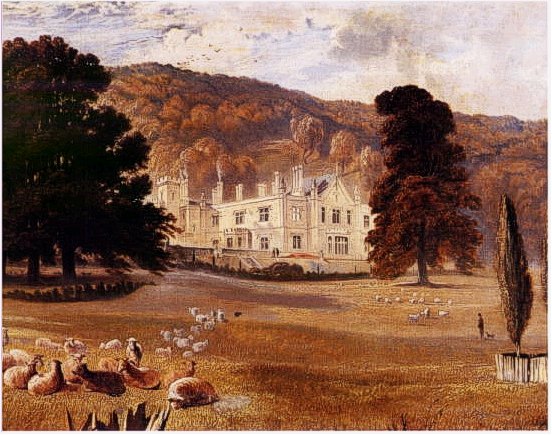Reverend George Turner Seymour originally came from Tyntes Place near Wraxall in Somerset. The house was a Regency Gothic-Tudor building and was built for Seymour in 1813 on land given him by his father, John Seymour. Subsequent additions were made by Robert Newton of Nailsea.

[Tyntesfield, A Fertile Fortune, James Miller. National Trust Books, 2006.]
"A sepia drawing, dated 1836, shows the first house before Newton's additions, without towers on the west front, no bay windows to the Drawing Room, and no terraced gardens. Fortunately, two further watercolours survive to show the outlines of the house twenty years later. The entrance front, as now, faced the drive from Belmont, with a centrally placed entrance tower with two-storied elevations on either side. The service wing was on the back, jutting into the hillside. The south front rose to a two-storied gabled centrepiece, with two bay windows taking in the panoramic view across the valley. The building may well have been stuccoed, with cast Gothic decorative details, including ogee pinnacles that look like pawns on a chessboard, peppering the skyline. ...
The three central rooms at the front of the house, on all floors, date from the Reverend Seymour's house and largely retain their original early nineteenth-century character. On the ground floor, the Oak Study, Morning Room and Ante-room were his original reception rooms. In the Oak Study even his fine grey marble fireplace survives. It is, however, in the Stuart bedroom on the first floor that one gets the clearest sense of Seymour's rooms, which were remarkably plain with simple mouldings and cornices, and panelled doors. This restraint, a word that will seldom be used again to describe the interiors, is matched by the simple white marble fire surround in the Gothic style."
English Heritage
IoE Number: 33585
Location: Tyntesfield House, Wraxall and Failand, North Somerset.
“Built 1813 for John Seymour. ... The bedrooms, service rooms and servants’ rooms all retain most of their original features including doors, doorcases, shutters, skirting boards and plaster ceilings. Many of the bedrooms retain their original early-nineteenth century 'Tudor' Gothic style decoration, especially their doorcases, doors and marble fireplaces.”
In 1843, he sold Tyntes Place to Willam Gibbs, a businessman, who enlarged it into a large, ornate Gothic home and changed its name to Tyntesfield House.
Seymour then bought Farringford, before moving to Cornwallis Crescent, Clifton, after he sold Farringford to Alfred Tennyson.
One reason for moving to the Isle of Wight may have been the marriage of his eldest daughter to the son of an Isle of Wight family of solicitors, the Sewells.
The Gentleman's Magazine by Sylvanus Urban, Gent. Vol. XIV, MDCCCXL July - December. London, 1840.
“Oct. 1840
Marriage
At Berne, R. B. Sewell, esq. of Millbrook, Isle of Wight, to Marianne-Billingsley, eldest dau. of the Rev. G. T. Seymour, of Tyntesfield, Wraxall, Som.”
Seymour’s daughter, Jane Fortescue Seymour (1825 - 1878), married John Duke Coleridge, 1st Baron Coleridge (1820 – 1894), Lord Chief Justice of England 1880 - 1894 and Baron of Ottery St Mary, on 11th August 1846 at Freshwater Church. She was described as “of Farringford, Isle of Wight.”
Hampshire Telegraph and Sussex Chronicle, Saturday, August 15, 1846; Issue 2445.
“On the 11th instant, at Freshwater, Isle of Wight, by the Rev. J. F. Isaacson, John Duke Coleridge, Esq. eldest son of the Hon. Mr. Justice Coleridge, to Jane Fortesque, third daughter of the Rev. G. T. Seymour, of Farringford, Isle of Wight.”
Seymour died in 1880.
Auction Wednesday 27th April 2005
Hampton & Littlewood, auctioneers
The Auction Rooms, Alphin Brook Road, Alphington, Exeter, Devon
To be sold by direction of The Lord Coleridge 5th Baron of Ottery St Mary
An imposing Charles X style gilt bronze surtout de table in five sections with curved ends, the mirror glass enclosed by a pierced trailing fruiting vine gallery, above a frieze of laurel leaves, raised on lions claw feet, the gallery with two attached oval plaques, each surmounted by a crown and with foliate surrounds, one with the arms of Coleridge and Seymour, the other inscribed ‘The Revd George Turner Seymour departed this life 14 Oct 1880 aged 88’.
60.2cm (1ft 11 3/4in) wide, x 249cm (8ft 2in) overall length, contained in a fitted travelling trunk with carrying handles to the sides.